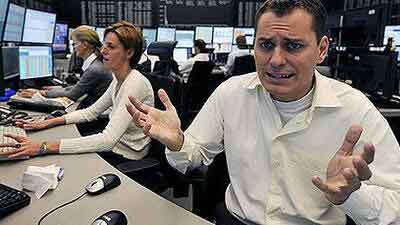Why Q1 Was So Strange
Nicholas Colas
 Q1 2022 saw the first sharp break lower for US/global equities since the March 2020 pandemic lows, so what happened and what does it say about current and near-future market narratives? Three points to answer that question: Q1 2022 saw the first sharp break lower for US/global equities since the March 2020 pandemic lows, so what happened and what does it say about current and near-future market narratives? Three points to answer that question:
First, here are price returns from the end of 2021 to the early-mid March 2022 lows for select global and US equity market indices:
- MSCI All-Country World Index: -13.1 percent (March 8th lows)
- MSCI All-Country ex-US Index: -13.3 pct (March 7th lows)
- S&P 500: -12.7 percent (March 8th lows)
- Russell 2000: -13.6 pct (March 14th lows, late January lows -14.1 pct)
- NASDAQ Composite: -20.1 pct (March 14th lows)
- MSCI Europe: -18.7 percent (March 7th lows)
- MSCI Japan: -13.0 pct (March 8th lows)
- MSCI Emerging Markets: -15.4 percent (March 14th lows)
- MSCI China: -28.4 pct (March 15th lows)
Comment: European and Chinese stocks forcefully dragged global equity markets lower from the start of the year to the early-mid March bottom. Rising oil prices and the Russia-Ukraine conflict explain Europe’s underperformance. Chinese equities had been under pressure since February 2021 due to a host of pandemic- and local Big Tech regulatory-related issues. Higher oil prices and continuing concerns about regulation put even more of a strain on China’s stock market from January – mid-March 2022. The NASDAQ and Russell, riskier indices with a perennially +1.0 beta, sold off harder than the S&P 500.
Now, here is how each of these indices has fared from their respective March lows through today:
- MSCI All-Country World Index: +9.0 percent
- MSCI All-Country ex-US Index: +8.3 pct
- S&P 500: +9.7 percent
- Russell 2000: +7.0 pct
- NASDAQ Composite: +14.1 pct
- MSCI Europe: +12.5 percent
- MSCI Japan: +6.2 pct
- MSCI Emerging Markets: +8.8 percent
- MSCI China: +18.8 pct
Comment: the snapback from the lows for global equities earlier this month was most pronounced in European and Chinese stocks, mirroring the returns during the meltdown. That the Russia-Ukraine crisis did not spiral into a wider European conflict has helped the region’s equity markets bounce back. Separately, the Chinese government finally realized that its local equity market was getting dangerously close to free-fall and stepped in to reassure investors that it understood it had to tread more lightly.
As for other reasons early-mid March was the low for global equities, consider the following:
- WTI Crude peaked on March 8th at $124/barrel, now $100/barrel
- Gold peaked on March 8th at $2,043/oz, now $1,923/oz
- Euro/dollar exchange rate troughed on March 7th at $1.085, now $1.100
- Chinese offshore yuan/dollar exchange rates peaked on March 14th at 6.395, now 6.385
- The CBOE VIX “Fear Gauge” Index peaked on March 7th at 36.5, now 19.6. The first number is 2 standard deviations from the mean, the second is the long run mean back to 1990.
So, we know oil, gold, currencies, and market fear all peaked at/near the lows, but here’s what DID NOT peak at the same time:
- 2-year Treasury yields, a market proxy for Fed policy, which were 1.6 – 1.7 percent mid-month but are 2.34 percent today.
- 10-year Treasury yields, a market proxy for the US neutral rate of interest, which were 1.9 – 2.0 percent mid-month but are 2.47 percent now.
- 10-year German and French sovereign bond yields, market proxies for the European neutral rate of interest, which were 0.00 – 0.75 percent mid-month but are 0.59 – 1.00 percent today.
Takeaway: geopolitics/oil prices and Chinese economic/commercial policy uncertainty were more important market narratives in Q1 than changing market perceptions of future Federal Reserve rate hikes. If a more hawkish Fed really were a market driver, we wouldn’t be rallying into quarter end with bond markets discounting ever-more aggressive Fed policy by the day. As for what captures the market’s attention in Q2, we think the 1-word answer is “earnings”. As long as Russia-Ukraine does not cause another oil price spike, the market only has to worry about Fed policy (which it now assumes will be aggressive) and corporate earnings power. That’s not a bad setup as we start the second quarter; if the last 2 years have shown us anything, it is that American companies know how to generate strong profits.

Nick is a 30+ year veteran of Wall Street with experience in equity research, money management and investment banking.
From 1991 to 1999 he was the senior equity auto analyst at First Boston (now Credit Suisse). In addition to his duties advising clients on investments in the sector, he was also active in a range of equity offerings and M&A assignments. These included several equity underwritings for Chrysler, as well as its eventual sale to Daimler Benz, along with IPOs in the auto parts, rental car, and Chinese auto industry sectors.
From 1999 – 2001, Nick was an analyst and portfolio manager at SAC Capital reporting directly to company founder Steve Cohen.
From 2003 – 2017 he was Director of Research and Chief Market Strategist for first Rochdale Securities and then Convergex Group. In the latter role he authored the firm’s Morning Markets Briefing, which became a daily must-read for thousands of Wall Street professionals.
Nick is regularly on CNBC and Bloomberg TV/Radio and is widely quoted in the financial press.
Nick received his MBA from the University of Chicago in 1991 and his undergrad degree from Haverford College in 1986, majoring in Near Eastern Archaeology. He is a lifelong New Yorker, born and raised in Manhattan.
www.datatrekresearch.com
|




